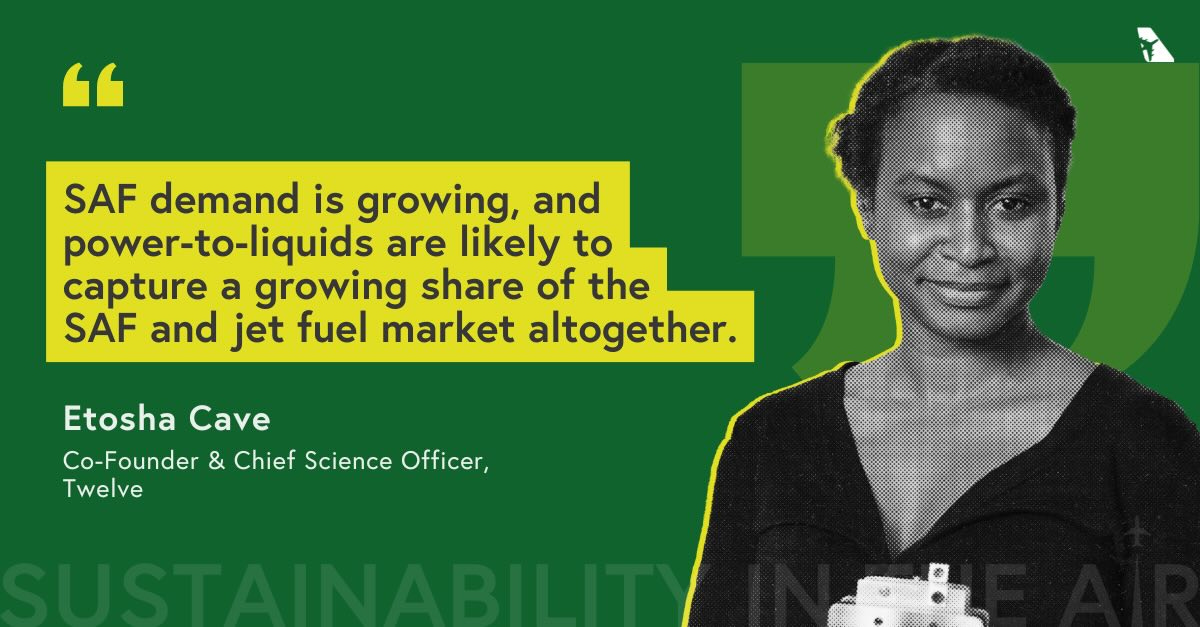In this episode of our ‘Sustainability in the Air’ podcast, Etosha Cave, Co-Founder and Chief Science Officer of Twelve, speaks with SimpliFlying CEO Shashank Nigam and shares how the carbon transformation company harnesses CO2 from industrial waste streams to produce e-fuels.
Cave brings a unique perspective to sustainable aviation, having spent five months working as a handywoman in Antarctica before pursuing her PhD at Stanford — her research there would become Twelve’s foundation. The company is currently building its first commercial plant in Moses Lake, Washington, and has partnerships with major airlines like Alaska Airlines, International Airlines Group (IAG) and United Airlines.
Twelve is one of the visionary companies featured in our new book Sustainability in the Air: Volume Two. You can learn more about the book and order a copy here.
Here are the key highlights of the conversation:
Turning an environmental crisis into scientific purpose (3:08)
Explaining artificial photosynthesis: mimicking trees to make jet fuel (10:05)
Why Moses Lake, Washington became Twelve’s first plant location (13:21)
Navigating political risk across three presidential administrations (15:41)
Building airline partnerships: from Alaska to IAG (17:55)
Balancing roles: chief science officer vs co-founder responsibilities (20:55)
SAF industry outlook and Twelve’s growing market role (28:04)
Rapid Fire! (29:14)
Keep reading for a detailed overview of the episode.
Why power-to-liquids could bypass SAF’s biggest bottlenecks
The sustainable aviation fuel (SAF) industry must scale production in a way that is both efficient and environmentally responsible to meet growing demand and climate targets. Conventional SAF pathways that rely on agricultural or biological feedstocks have their own environmental and logistical constraints.
Twelve uses a process called carbon transformation to convert waste CO2, water, and renewable electricity into hydrocarbons through electrochemical reactions, with only water and oxygen as byproducts. The hydrocarbons serve as building blocks that can be used to make the same chemicals, materials, and fuels from CO2 that are conventionally made from fossil fuels.
“Trees take CO2 from the air and water from the ground, then use sunlight and natural catalysts in their leaves to convert them into sugars,” Cave explains.
“Our technology does something similar: we capture CO2 from industrial emissions or the air, combine it with water, and use metal catalysts and renewable electricity to create new carbon molecules, which we then process into jet fuel.”
This power-to-liquids process is resource-intensive but offers unique scalability benefits. Instead of relying on biological growth cycles or specific land use, Twelve’s system can be established wherever renewable electricity and a CO2 source are accessible.
4 takeaways from the conversation
1. Turning an environmental crisis into scientific purpose
As a teenager in Houston, Cave witnessed a class action lawsuit in her neighbouring community where an abandoned oil and gas waste site had contaminated the local water supply, leading to increased rates of rare diseases.
“Having friends and neighbours going through that experience really impacted me,” Cave recalls. “It put me on a path to explore clean energy, how we deal with waste, how we keep the planet and humanity in harmony, and how we move away from causing harm.”
This experience shaped her approach to problem-solving through science rather than activism. “I never saw myself as a politician, writer, or activist. I’ve always loved science and maths, so I thought: how can I use that passion to make a difference now and for future communities?”
Cave’s work in Antarctica also served as a formative experience. Spending five months in an extreme environment surrounded by scientists studying climate and marine life reinforced her commitment to environmental solutions. The experience offered intimate exposure to nature and research that would later influence her approach to carbon transformation.
2. Building airline partnerships in a challenging market
Twelve’s collaborations with Alaska Airlines, IAG and United Airlines Ventures reflect a strategic approach to growing the SAF market.
Instead of relying on standard offtake agreements, the company builds on a mix of consumer demand, regulatory pressure, and corporate climate goals to create strong, practical business cases.
The company’s business development team focuses on finding alignment between Twelve’s capabilities and airline needs.
However, Cave acknowledges the economic challenges. “We’re developing a first-of-its-kind technology, so the initial production will be more expensive. But we can offset that by tapping into federal and state incentives, and by meeting the strong demand from customers who want to address their carbon footprint.”
3. Setting up the first commercial plant in Washington
Twelve’s decision to build its first commercial plant in Moses Lake, Washington, highlights how cleantech companies weigh multiple factors when choosing where to scale. While it may seem like a remote location, Moses Lake offers a mix of advantages that are hard to find in larger metropolitan areas.
“There’s a lot of hydropower in Moses Lake, and substations already set up to handle that capacity—which we were able to tap into,” says Cave. “For us, it was really important to find land and power that were ready to go so we could move quickly.”
The area’s clean energy infrastructure had previously attracted cryptocurrency operations, but state policymakers have since shifted focus. “Washington had a big wave of crypto interest, and then realised they wanted to make that renewable power available for other industries,” Cave explains. “Now, the playing field is more open for companies like ours to take advantage of that clean electricity.”
In addition to abundant hydropower, the site offers other key benefits: state-level incentives, including a low carbon fuel standard similar to California’s; proximity to major partners like Alaska Airlines; and lower land costs than urban tech hubs.
4. Navigating political uncertainty
Having operated through the Obama, Trump, and Biden administrations, Twelve has gained valuable perspective on how cleantech companies can stay resilient in a shifting political landscape. For Cave, the lesson is clear: long-term success in climate tech means planning for political change, not just policy alignment.
“Carbon management has proven to be a bipartisan opportunity,” Cave explains. “Both parties have seen the value in using CO2 to create jobs and grow the economy.”
This broad appeal is driven more in economic potential than environmental ideology, and has helped carbon management maintain steady support, even amid political swings.
Twelve’s strategy is designed with that in mind. The company focuses on long-term incentives and keeps its operations geographically flexible, allowing it to adapt to changing political climates.
Looking ahead, Cave has an ambitious vision for the company’s future. “When I think about energy companies that have been around for 150 or 200 years, I imagine Twelve a century from now, growing to the scale of today’s oil and gas giants, if not beyond.”
However, reaching that scale won’t be easy. It will require continued technical innovation, strong partnerships, and supportive policies.
Get our new book
Our new book Sustainability in the Air: Volume Two is now available for purchase on Amazon. Learn more about the startups, strategists, and sceptics working to close the gap between growth and green ambition.
‘Sustainability in the Air’ is the world’s leading podcast dedicated to sustainable aviation. Through in-depth conversations with top aviation leaders, we break through the clutter and provide a clear roadmap for a net-zero future.













